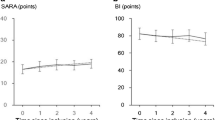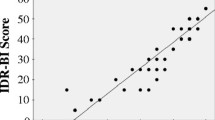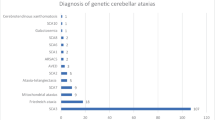Abstract
Sporadic spinocerebellar ataxias (SCAs) comprise heterogeneous diseases with poorly understood epidemiologies and etiologies. A population-based epidemiological analysis of sporadic ataxias in the Japanese population was described. The prevalence rate of SCAs in the Japanese population is estimated to be 18.5/100,000. Sporadic SCAs account for 67.2% of total SCAs including hereditary SCAs, with olivopontocerebellar atrophy (OPCA) being the most common form sporadic ataxia (64.7%). The natural history analysis conducted on the basis of International Cooperative Ataxia Rating Scale (ICARS) showed that only 33% of patients with OPCA were able to walk at least with one stick 4–5 years after the onset of OPCA, which is much less than that of patients with cortical cerebellar atrophy (CCA). Similarly, 43% of patients with OPCA were able to stand alone 4–5 years after the onset, while 76% of patients with CCA were able to stand alone at the same disease duration. A population–based epidemiological analysis should provide essential information on the natural history of SCAs.
Similar content being viewed by others
References
Takano H, Cancel G, Ikeuchi T, Lorenzetti D, Mawad R, Stevanin G, Didierjean O, Durr A, Oyake M, Shimohata T, Sasaki R, Koide R, Igarashi S, Hayashi S, Takiyama Y, Nishizawa M, Tanaka H, Zoghbi H, Brice A, Tsuji S. Close associations between prevalences of dominantly inherited spinocerebellar ataxias with CAG-repeat expansions and frequencies of large normal CAG alleles in Japanese and Caucasian populations. Am J Hum Genet. 1998;63:1060–6.
Schöls L, Bauer P, Schmidt T, Schulte T, Riess O. Autosomal dominant cerebellar ataxias: clinical features, genetics, and pathogenesis. Lancet Neurol. 2004;3(5):291–304.
Dejerine J, Andre-Thoma. L’atrophie olivo-pontocerebelleuse. Nouvelle iconographie de la Salpetriere. 1900;13:330–70.
Wakabayashi K, Hayashi S, Kakita A, Yamada M, Toyoshima Y, Yoshimoto M, Takahashi H. Accumulation of alpha-synuclein/NACP is a cytopathological feature common to Lewy body disease and multiple system atrophy. Acta Neuropathol (Berl). 1998;96(5):445–52.
SpillantiniMG, Crowther RA, Jakes R, Cairns NJ, Lantos PL, Goedert M. Filamentous alpha-synuclein inclusions link multiple system atrophy with Parkinson’s disease and dementia with Lewy bodies. Neurosci Lett. 1998;251(3):205–8.
Graham JG, Oppenheimer DR. Orthostatic hypotension and nicotine sensitivity in a case of multiple system atrophy. J Neurol Neurosurg Psychiatry. 1969;32(1):28–34.
Adams RD, Vanbogaert L, Vandereecken H. Strao-Nigral Degeneration. J Neuropathol Exp Neurol. 1964;23:584–608.
Shy GM, Drager GA. A neurological syndrome associated with orthostatic hypotension: a clinical-pathologic study. Arch Neurol. 1960;2:511–27.
Gilman S, Low PA, Quinn N, Albanese A, Ben-Shlomo Y, Fowler CJ, Kaufmann H, Klockgether T, Lang AE, Lantos PL, Litvan I, Mathias CJ, Oliver E, Robertson D, Schatz I, Wenning GK. Consensus statement on the diagnosis of multiple system atrophy. J Neurol Sci. 1999;163(1):94–8.
Wenning GK, Tison F, Seppi K, Sampaio C, Diem A, Yekhlef F, Ghorayeb I, Ory F, Galitzky M, Scaravilli T, Bozi M, Colosimo C, Gilman S, Shults CW, Quinn NP, Rascol O, Poewe W. Development and validation of the Unified Multiple System Atrophy Rating Scale (UMSARS). Mov Disord. 2004;19(12):1391–402.
Marie P, Foix C, Alajouanine T. De l’atrophie cerebelleuse tardive a predominance corticale. Rev Neurol. 1922;ii:849–85.
Baloh RW, Yee RD, Honrubia V. Late cortical cerebellar atrophy. Clinical and oculographic features. Brain. 1986;109(PT 1):159–80.
Kanazawa I, Kwak S, Sasaki H, Mizusawa H, Muramoto O, Yoshizawa K, Nukina N, Kitamura K, Kurisaki H, Sugita K. Studies on neurotransmitter markers and neuronal cell density in the cerebellar system in olivopontocerebellar atrophy and cortical cerebellar atrophy. J Neurol Sci. 1985;71(2–3):193–208.
Harding AE. ‘Idiopathic’ late onset cerebellar ataxia. A clinical and genetic study of 36 cases. J Neurol Sci. 1981;51(2):259–71.
Furneaux HM, Rosenblum MK, Dalmau J, Wong E, Woodruff P, Graus F, Posner JB. Selective expression of Purkinje-cell antigens in tumor tissue from patients with paraneoplastic cerebellar degeneration. N Engl J Med. 1990;322(26):1844–51.
Sillevis Smitt P, Kinoshita A, De Leeuw B, Moll W, Coesmans M, Jaarsma D, Henzen-Logmans S, Vecht C, De Zeeuw C, Sekiyama N, Nakanishi S, Shigemoto R. Paraneoplastic cerebellar ataxia due to autoantibodies against a glutamate receptor. N Engl J Med. 2000;342(1):21–7.
Darnell RB, Posner JB. Paraneoplastic syndromes involving the nervous system. N Engl J Med. 2003;349(16):1543–54.
Abele M, Weller M, Mescheriakov S, Bürk K, Dichgans J, Klockgether T. Cerebellar ataxia with glutamic acid decarboxylase autoantibodies. Neurology. 1999;52(4):857–9.
Saiz A, Arpa J, Sagasta A, Casamitjana R, Zarranz JJ, Tolosa E, Graus F. Autoantibodies to glutamic acid decarboxylase in three patients with cerebellar ataxia, lateonset insulin-dependent diabetes mellitus, and polyendocrine autoimmunity. Neurology. 1997;49(4):1026–30.
Hadjivassiliou M, Gibson A, Davies-Jones GA, Lobo AJ, Stephenson TJ, Milford-Ward A. Does cryptic gluten sensitivity play a part in neurological illness? Lancet. 1996;347(8998):369–71.
Hadjivassiliou M, Grünewald RA, Chattopadhyay AK, Davies-Jones GA, Gibson A, Jarratt JA, Kandler RH, Lobo A, Powell T, Smith CM. Clinical, radiological, neurophysiological, and neuropathological characteristics of gluten ataxia. Lancet. 1998;352(9140):1582–5.
Selim M, Drachman DA. Ataxia associated with Hashimoto’s disease: progressive non-familial adult onset cerebellar degeneration with autoimmune thyroiditis. J Neurol Neurosurg Psychiatry. 2001;71(1):81–7.
Sitrin MD, Lieberman F, Jensen WE, Noronha A, Milburn C, Addington W. Vitamin E deficiency and neurologic disease in adults with cystic fibrosis. Ann Intern Med. 1987;107(1):51–4.
Eggermont E. Recent advances in vitamin E metabolism and deficiency. Eur J Pediatr. 2006;165(7):429–34.
Trouillas P, Takayanagi T, Hallett M, Currier RD, Subramony SH, Wessel K, Bryer A, Diener HC, Massaquoi S, Gomez CM, Coutinho P, Ben Hamida M, Campanella G, Filla A, Schut L, Timann D, Honnorat J, Nighoghossian N, Manyam B. International Cooperative Ataxia Rating Scale for pharmacological assessment of the cerebellar syndrome. The Ataxia Neuropharmacology Committee of the World Federation of Neurology. J Neurol Sci. 1997;145(2):205–11.
Mori M, Adachi Y, Kusumi M, Nakashima K. A genetic epidemiological study of spinocerebellar ataxias in Tottori prefecture, Japan. Neuroepidemiology. 2001;20(2):144–9.
Zortea M, Armani M, Pastorello E, Nunez GF, Lombardi S, Tonello S, Rigoni MT, Zuliani L, Mostacciuolo ML, Gellera C, Di Donato S, Trevisan CP. Prevalence of inherited ataxias in the province of Padua, Italy. Neuroepidemiology. 2004;23(6):275–80.
Vanacore N, Bonifati V, Fabbrini G, Colosimo C, De Michele G, Marconi R, Nicholl D, Locuratolo N, Talarico G, Romano S, Stocchi F, Bonuccelli U, De Mari M, Vieregge P, Meco G. Epidemiology of multiple system atrophy. ESGAP Consortium. European Study Group on Atypical Parkinsonisms. Neurolog Sci. 2001;22(1):97–9.
Hirayama K, Takayanagi T, Nakamura R, Yanagisawa N, Hattori T, Kita K, Yanagimoto S, Fujita M, Nagaoka M, Satomura Y. Spinocerebellar degenerations in Japan: a nationwide epidemiological and clinical study. Acta Neurol Scand. 1994;Suppl. 153:1–22.
Ishikawa K, Toru S, Tsunemi T, Li M, Kobayashi K, Yokota T, Amino T, Owada K, Fujigasaki H, Sakamoto M, Tomimitsu H, Takashima M, Kumagai J, Noguchi Y, Kawashima Y, Ohkoshi N, Ishida G, Gomyoda M, Yoshida M, Hashizume Y, Saito Y, Murayama S, Yamanouchi H, Mizutani T, Kondo I, Toda T, Mizusawa H. An autosomal dominant cerebellar ataxia linked to chromosome 16q22.1 is associated with a single-nucleotide substitution in the 59 untranslated region of the gene encoding a protein with spectrin repeat and Rho guanine-nucleotide exchange-factor domains. Am J Hum Genet. 2005;77(2):280–96.
Ouyang Y, Sakoe K, Shimazaki H, Namekawa M, Ogawa T, Ando Y, Kawakami T, Kaneko J, Hasegawa Y, Yoshizawa K, Amino T, Ishikawa K, Mizusawa H, Nakano I, Takiyama Y. 16q–linked autosomal dominant cerebellar ataxia: a clinical and genetic study. J Neurol Sci. 2006;247(2):180–6.
Hara K, Momose Y, Tokiguchi S, Shimohata M, Terajima K, Onodera O, Kakita A, Yamada M, Tkahashi H, Hirasawa M, Mizuno Y, Ogata K, Goto J, Kanazawa I, Nishizawa M, Tsuji S. Multiplex families with multiple system atrophy. Arch Neurol. 2007;34:00.
Author information
Authors and Affiliations
Consortia
Corresponding author
Additional information
*Shoji Tsuji, Osamu Onodera, Ichiro Kanazawa, Hidehiro Mizusawa, Takamichi Hattori, Gen Sobue, Mitsunori Yamada, Yoshiyuki Kuroiwa, Akira Kakizuka, Atsushi Takeda, Kazuko Hasegawa, Tatsuhiko Yuasa, Takemasa Kanda, Kunihiro Yoshida, Teruhiko Kachi, Takashi Nakajima, Mitsuhiro Osame, Sadako Kuno, Kenji Nakajima, Hideshi Kawakami, Yoshitaka Nagai, and Masatoyo Nishizawa.
Rights and permissions
About this article
Cite this article
Tsuji, S., Onodera, O., Goto, J. et al. Sporadic ataxias in Japan – a population-based epidemiological study. Cerebellum 7, 189–197 (2008). https://doi.org/10.1007/s12311-008-0028-x
Published:
Issue Date:
DOI: https://doi.org/10.1007/s12311-008-0028-x




